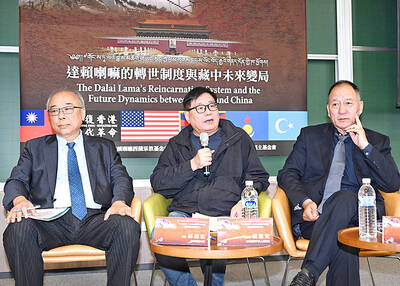An Air Force official yesterday told the legislature that the US could announce the approval of the sale of F-16C/D fighter aircraft to Taiwan as early as June.
“We have learned that the US military supports the F-16 deal and are optimistic that the US might announce the sale after May,” Air Force Chief of Staff Major General Liu Chen-wu (劉震武) told the legislature’s Diplomacy and National Defense Committee.
He said the military was awaiting the announcement.
The military expected to sign a letter of offer and acceptance for the deal in November and that at the time the military offered to make an initial payment of NT$19.9 billion (US$653.8 million), he said.
The military’s budget request in 2006 showed that the Cabinet had allocated NT$16.03 billion to begin the procurement of F-16s, even though Washington had yet to approve the deal.
The initial payment was only a fraction of the total cost for 66 aircraft. But the funds were returned after the US did not approve the arms deal.
The legislature set aside NT$20 billion for the purchase of F-16s last year, but it requested that the funds be frozen until the deal was approved.
Liu made the presentation to the legislative committee with the hope that the committee could support funding for the acquisition.
The committee agreed yesterday to unfreeze the funds if and when the US has announced the deal.

ALIGNED THINKING: Taiwan and Japan have a mutual interest in trade, culture and engineering, and can work together for stability, Cho Jung-tai said Taiwan and Japan are two like-minded countries willing to work together to form a “safety barrier” in the Indo-Pacific region, Premier Cho Jung-tai (卓榮泰) yesterday said at the opening ceremony of the 35th Taiwan-Japan Modern Engineering and Technology Symposium in Taipei. Taiwan and Japan are close geographically and closer emotionally, he added. Citing the overflowing of a barrier lake in the Mataian River (馬太鞍溪) in September, Cho said the submersible water level sensors given by Japan during the disaster helped Taiwan monitor the lake’s water levels more accurately. Japan also provided a lot of vaccines early in the outbreak of the COVID-19 pandemic,

Kaohsiung Mayor Chen Chi-mai (陳其邁) on Monday announced light shows and themed traffic lights to welcome fans of South Korean pop group Twice to the port city. The group is to play Kaohsiung on Saturday as part of its “This Is For” world tour. It would be the group’s first performance in Taiwan since its debut 10 years ago. The all-female group consists of five South Koreans, three Japanese and Tainan’s Chou Tzu-yu (周子瑜), the first Taiwan-born and raised member of a South Korean girl group. To promote the group’s arrival, the city has been holding a series of events, including a pop-up

TEMPORAL/SPIRITUAL: Beijing’s claim that the next Buddhist leader must come from China is a heavy-handed political maneuver that will fall flat-faced, experts said China’s requirement that the Dalai Lama’s reincarnation to be born in China and approved by Beijing has drawn criticism, with experts at a forum in Taipei yesterday saying that if Beijing were to put forth its own Dalai Lama, the person would not be recognized by the Tibetan Buddhist community. The experts made a remarks at the two-day forum hosted by the Tibet Religious Foundation of His Holiness the Dalai Lama titled: “The Snow Land Forum: Finding Common Ground on Tibet.” China says it has the right to determine the Dalai Lama’s reincarnation, as it claims sovereignty over Tibet since ancient times,

Temperatures in some parts of Taiwan are expected to fall sharply to lows of 15°C later this week as seasonal northeasterly winds strengthen, the Central Weather Administration (CWA) said today. It is to be the strongest cold wave to affect northern Taiwan this autumn, while Chiayi County in the southwest and some parts of central Taiwan are likely to also see lower temperatures due to radiational cooling, which occurs under conditions of clear skies, light winds and dry weather, the CWA said. Across Taiwan, temperatures are to fall gradually this week, dropping to 15°C to 16°C in the early hours of Wednesday